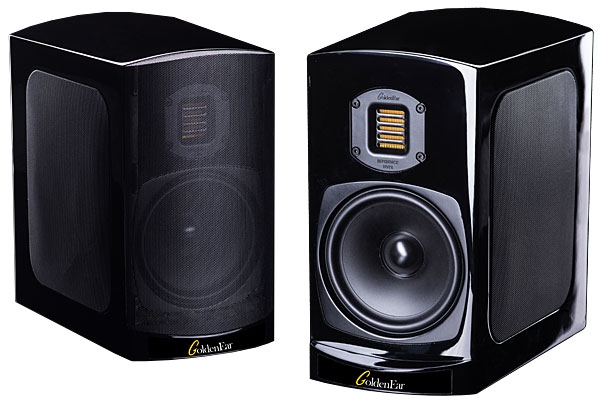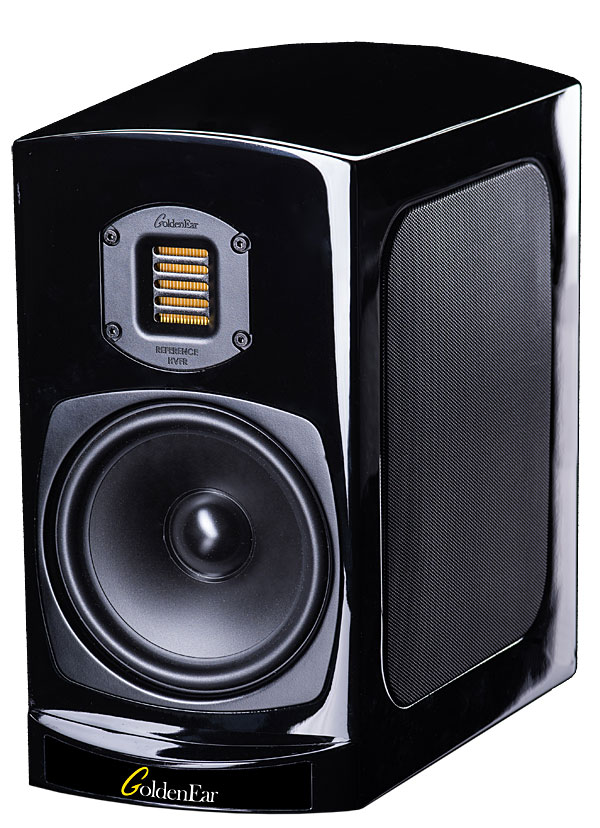| Columns Retired Columns & Blogs |
As a less expensive alternative to Parasound JC1+, one of the good choices would be the Mark Levinson 5805 integrated amp ...... Stereophile measurements show ML 5805 can handle 2 Ohm loads :-) ........

When Stereophile Editor Jim Austin asked if I would be interested in reviewing GoldenEar's new stand-mounted design, the BRX (for Bookshelf Reference X), which is competitively priced at $1599/pair, I was interested to find out if what I had liked about the brand's floorstanding models had trickled down.
The BRX
"Trickle down" is the appropriate term: The BRX does indeed feature technology from GoldenEar's Triton Reference. The 6" polypropylene-cone woofer is basically the same as the Triton Reference's upper-bass/midrange driver, with its cast basket, low-mass voice-coil, and what GoldenEar calls a Focused Field magnet structure, designed to better direct the magnetic flux into the voice-coil gap. However, the BRX's implementation of this drive-unit has a conventional dustcap rather than the ribbed pole-piece extension featured in the Reference. The BRX woofer is reflex-loaded with a pair of 6.5" flat passive radiators, one mounted on each sidewall so that their reactive forces cancel.
The BRX's tweeter is the HVFR (High-Velocity Folded Ribbon) unit used in the Triton Reference. This driver, which uses a neodymium magnet, is a development of the Air-Motion Transformer that was invented by the late Oskar Heil in the 1970s. An aluminum voice-coil is deposited on a plastic substrate, and the resulting diaphragm is folded into accordion-style pleats. When current is passed through the conductors, air is squeezed in and out of the pleats, generating sound. The Heil patent expired in 2004, and variations of this high-sensitivity drive-unit are now used by a number of speaker brands. The crossover is said by GoldenEar to use a "floating" configuration utilizing high-quality film capacitors, and electrical connection is via a recessed pair of binding posts on the speaker's rear panel.
Like all the GoldenEar models, the BRX, which is manufactured in China, features an immaculate high-gloss, piano-black lacquer finish. The cabinet is wider at the rear than it is at the front, and its base is fitted with rubber feet. A small lip at the bottom of the front baffle supports the magnetically attached, black metal-mesh grille.
Setup
I initially sat the GoldenEars on the 24" Celestion stands that I use for bookshelf speakers, these placed where the similar-sized KEF LS50s have worked best in my room. However, with the 24" stands, I found that I needed to slump in my seat to get the optimal mid-treble balance from the BRXes. I replaced the Celestion stands with the Sanus SF30 stands recommended by Sandy Gross. These 30" twin-pillar stands placed my ears just below the tweeter axis, which was 38" from the floor with the stands fitted with carpet-piercing spikes.

The upper bass was a little lighter-balanced with the GoldenEars on the taller stands than it had been on the shorter Celestion stands, so I experimented with positioning. The woofer of the left-hand BRX ended up 30" from the LPs that line the nearest sidewall; the right-hand speaker's woofer was 39" from the bookshelves that line its sidewall. Both woofers were 72" from the wall behind them. I couldn't place the speakers any closer to the wall due to a raised platform behind the right-hand BRX that leads to the vestibule.
The BRXes were toed in to point directly at the listening position. Although I had filled the pillars of my Celestion stands with a mix of sand and lead shot to damp resonances, the Sanus stand's pillars are empty and not easily filled. The Sanus stands decouple the top plate from the pillars with cork washers; I added my usual pads of Blu Tack between the BRX's base and the stand's top plate and damped the pillars by resting cloth bags filled with lead shot against their bases.
Listening
Once I had finalized the positions of the GoldenEar BRXes, I started my serious listening, driving the speakers first with the Parasound Halo JC 1+ monoblocks that I reviewed in the June 2020 issue, then with the NAD M10 integrated amplifier that I purchased after my review in January. Initially, I didn't use the grilles, but I found later that the mid-treble balance was usefully a tad less forward-sounding with the grilles in place.
The dual-mono pink noise track on my Editor's Choice CD (Stereophile STPH016-2) acquired a bit of low-treble emphasis if I sat so that I could see the tops of the cabinets, but it sounded evenly balanced, uncolored, and smooth when I sat with my ears just below the BRXes' tweeters. With the grilles on, the central image of the noise signal was extremely narrow, with no splashing to the sides at any frequency. When I removed the grilles, a little more "Vertical Venetian Blind" effect was audible when I moved from side to side (footnote 2), the opposite of what I was expecting.
The BRXes reproduced the 1/3-octave warble tones on Editor's Choice with good weight down to the 50Hz band. The 40Hz tone was just audible, as was the 32Hz tone, which got some help from the lowest-frequency mode in my room. The 25Hz and 20Hz warbles were inaudible. The half-step–spaced low-frequency tonebursts on Editor's Choice spoke cleanly down to 50Hz, with no emphasis of any of the tones. When I listened to the speakers' top panels with a stethoscope while these tones played, I could hear some low-level vibrational modes between 256Hz and 512Hz. Overall, the enclosure is well-damped, however.
Footnote 2: Also known as picket-fencing. See the entry in J. Gordon Holt's Glossary.

As a less expensive alternative to Parasound JC1+, one of the good choices would be the Mark Levinson 5805 integrated amp ...... Stereophile measurements show ML 5805 can handle 2 Ohm loads :-) ........

Thank you JA2 for reviewing the ML 5805 and doing the 'heavy lifting' :-) .......

JA1 should include the ML 5805 as one of his reference (integrated) amplifiers as a part of his reference amplifier arsenal :-) .........

Is it possible for JA1 to do the EPDR measurements in retrospect, for at least some of the class-A speakers? ...... The impedance and phase measurements are already available for those speakers :-) ......

JA1 says, "I don't have time for that EPDR measurements ..... Go buy the Parasound JC1+ amps" ....... Just kidding .... Just kidding :-) .......

Is it possible for JA1 to do the EPDR measurements in retrospect, for at least some of the class-A speakers?
I have started doing that. The Volti Razz review now has the EPDR figures - https://www.stereophile.com/content/volti-audio-razz-loudspeaker-measurements - and I will be adding more as time goes by.
John Atkinson
Technical Editor, Stereophile


TG liked the sound of Volti Razz speakers better with the Bel Canto e1X amp ...... EPDR measurements explain the reason in a better way :-) .......

I love 'stand mounts.'
They make for easy in n' out for switching speakers, which makes for awesome shoot outs!
These seem like winners.
I've been ogling the Legacy Calibre, too.
I also watch for Sonus Faber Extremas, but the have simply refused to depreciate worth a damn!
Thanks again for this review. Any chance you will keep it around for more comparisons?
Last question: Would have any working memory of the Crystal Cable Arabesque speaker for a few comparison comments?

Crystal Cable Arabesque speakers ($20,000/pair) are certainly memorable for their looks :-) .......

Good work, man.
;-D

Another audio component whose beauty is only skin deep :-) ........

Thanks again for this review.
You're welcome.
Any chance you will keep it around for more comparisons?
Herb Reichert now has the BRXes for a possible followup review.
Last question: Would have any working memory of the Crystal Cable Arabesque speaker for a few comparison comments?
Too many speakers have passed through my listening room for me to be able to offer any thoughts on the comparison. Sorry.
John Atkinson
Technical Editor, Stereophile

My 'crystal ball' says, HR likes the sound of BRX with LKV PWR+ and Bel Canto REF600M ...... Both have 3rd harmonic distortion and both can handle 2 Ohm loads :-) ......

BTW .... May be HR could do a follow-up review of the Parasound A21+ ($3,000) :-) .......

By what Sandy Gross and company pull off for the price. I don't care where its made. Exceptional engineering, design, and quality control.

they usually don't measure this well. Very similar to the Elac, at least in this case

It would be a good idea, if GoldenEar uses the same tweeter for their top model speakers :-) ......

to subjectively compensate for the extremely deep bass response on the other models

Some of the young people who can hear up to and above 15 kHZ, have complained about harsh treble in GoldenEar top models in the Stereophile web forum :-) .......

Especially in how it relates to the loudspeaker's efficiency is much, much better than the Elac

and I examine everything he does with a keen interest, but Sandy's got him beat on this one.